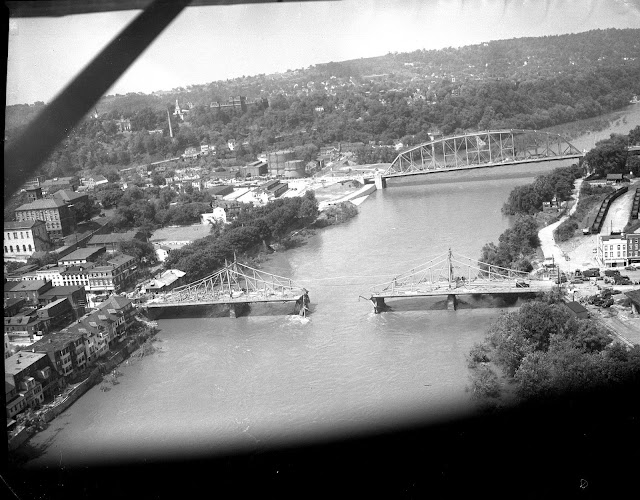By Rory Morgan - 2019
 |
| May 30, 1918 - Centre Square in Easton On the left is the text of Mayor David Nevin's speech. |
The United States was actively involved in World
War I for less than two years, from April 1917, until the Armistice in November,
1918. In that short time, the nation created, by recruiting and drafting, an
Army of approximately 4 million men. It trained (more or less), equipped,
clothed, and fed them. It transported 2 million of them to France; there they
joined the exhausted British and French forces, which had been fighting against
Germany since 1914.
The man primarily responsible for this success
was Easton native Peyton Conway “Bob” March, the Army Chief of Staff for most
of 1918. Born in 1864, he was one of the nine children of world-renowned
Lafayette College professor Francis A. March and his wife, Mildred. Peyton was
raised in the family’s house on the College campus and attended the Easton
schools. He enrolled at Lafayette at age 15, and graduated with honors in 1884.
While there, he was a member of Delta Kappa Epsilon social fraternity and
enthusiastically participated in athletic activities, especially baseball. He
also reportedly played on Lafayette’s first football team.
After graduation, he made a surprising choice -
to pursue a second undergraduate experience, this time as a cadet at the United
States Military Academy at West Point, NY. He secured the necessary appointment
from local Congressman William Mutchler, graduated from the Academy in 1888 and
received a commission as a 2nd Lieutenant in the artillery, stationed in
Washington, D.C.
Advancement opportunities were very limited in
the small Army of that era. It was not until 1894 - six years after his initial
commission - that he received a promotion and a new assignment. Before he and
his wife, Josephine headed west to his new post, San Francisco, they enjoyed a
three-month visit to Easton. For the next several years, he was occupied with
the routine duties of an Army officer in peacetime.
In 1898, the sad affair known as the
Spanish-American War began. Fighting in the Spanish colonies of Cuba and the
Philippines, the United States easily defeated Spain. (Although not without a
price - Easton native General Charles Wikoff was killed in Cuba. He was the
highest-ranking American officer to be killed in the war.)
War meant opportunity for a professional
soldier, no less for March than for any other officer. His chance came when
John Jacob Astor, one of the wealthiest men in America, announced that he would
personally pay all of the expenses of a new artillery battery for the Army.
Organizing and commanding the Astor Battery, as it inevitably came to be known,
was a prestigious assignment. It was given to Lieutenant March, signaling his
status as an up-and-coming officer. The battery was sent to the Philippines,
where March demonstrated leadership abilities and physical bravery. He
personally led a charge (unusual for an artillery officer) that resulted in his
nomination for the Medal of Honor - although he did not, in the end,
actually receive it.
When the war ended in late 1898, March returned
to the United States. He, Josephine and their children took the opportunity to
enjoy several weeks in Easton.
Unfortunately, the end of the Spanish war did
not bring peace to the Philippines. The Filipinos believed that the Americans
would treat them as an independent nation. Instead, the United States imposed a
government that effectively treated the Islands as an American colony. The
Filipinos revolted in 1899; the Philippine Insurrection proved to be a longer,
bloodier and uglier fight than the earlier war with Spain.
March eagerly accepted an invitation to return
to the Philippines to serve on the staff of Major General Arthur McArthur
(whose son, Douglas, would eventually achieve his own military fame). He was
later assigned to command an infantry regiment, gaining additional combat
experience and valuable exposure to the Army’s leaders.
The Insurrection ended in 1901 and March
returned to duty in the United States. In 1903, he was selected to join the
Army’s new General Staff, made up of some of the service’s most-highly-regarded
officers. Another noteworthy assignment came in 1904, when he was sent to Asia
to observe the now-forgotten Russo-Japanese War. However, the death of his wife
in November triggered his return home. Peyton and Josephine had five children
by then - three daughters and two sons. The youngest - son Lewis - was
still an infant when his mother died. Family members cared for the children
during March’s lengthy trip home, and continued to assist him until the
children were grown.
The following years were relatively quiet for
the Army and for March. He commanded a Field Artillery unit for several years.
He then was moved into the Adjutant General’s department for several more
years, doing work that was primarily administrative - keeping paper moving
along instead of keeping the Field Artillery’s caissons rolling along. As he
had experienced at the beginning of his career, desirable command spots were
scarce and there was fierce competition to get them. March had to learn to
fight bureaucratic battles instead of wartime battles.
In August,1914, everything changed. Europe
exploded into war: Germany invaded France. Britain quickly joined the fight
alongside the French. The United States stayed out of the war for over two
years, but in 1917 declared war on Germany. Although the British and French
armies were desperate for the additional manpower from America, that manpower
was more theoretical than actual; the Army and National Guard combined totaled
just 200,000 men. As March himself put it, such a small force was “of no
practical military value” in a war involving millions.
Nevertheless, American soldiers began to slowly
arrive in France. They were formally named the American Expeditionary Force or
AEF; informally, they were known as the “doughboys”. March initially commanded
all of the AEF’s artillery - an interesting challenge, given that the doughboys
arrived in Europe without any cannons and had to borrow them from the
French.
By the spring of 1918, Washington realized that
the Army’s administration was completely inadequate to handle the enormous
demands placed upon it. A strong officer was needed at the top and the
spotlight turned to March, by now a Major General. He stood 6’2”, with a
military bearing, a cold, blue-eyed stare, and a cutting tongue when necessary.
He had a reputation for making fast and firm decisions. All in all, he was
ideally suited to shake the Army’s attitude from placidity to urgency. He was
ordered to return to Washington as the Army Chief of Staff, to serve as the
link between the civilian Secretary of War and the Army’s command structure. He
soon realized that the Army’s various bureaus and departments were undermanned,
disorganized and lackadaisical; his work to resolve the problems was
relentless.
Meanwhile, Easton was fully aware of his career
progress to the highest ranks of his profession. In his honor, City Council
changed the name of New Street to March Street. In May, he returned to Easton
to accept a ceremonial sword, purchased via citywide fundraising campaign and
presented by Mayor David Nevin. Lafayette College awarded him an honorary
Doctor of Laws degree. The College’s alumni gifted him a horse (whose eventual
fate is unknown).
In the midst of his ceaseless labors, he
suffered the loss of his oldest son. Army Lieutenant Peyton C. March, Jr. was
killed while in pilot training. (California’s March Field, later March Air
Force Base, was named for the young soldier.) This tragedy was perhaps somewhat
eased by the marriages, within six months of each other, of his three daughters
- Mildred, Josephine and Vivian. They all married Army officers. Because
Mildred’s husband was stationed in France, she lived with her father and
handled housekeeping for him. (The youngest March – son Lewis – broke with the
family’s Army tradition by joining the Marine Corps in 1921. Unfortunately, he died
of tuberculosis in 1928.)
Those who achieve high positions in large
organizations generally have large egos and strong opinions. March was no
exception. His obsessive drive to achieve efficiency made him enemies, at least
in the bureaucratic sense. His relationship with the Army’s field commander,
General of the Armies John J. Pershing, was often strained, as Pershing
continually demanded more of everything: more men, more vehicles, more supplies.
March struggled to meet these demands. His dealings with Congressmen often
resulted in bruised feelings on the part of the politicians. But, despite all
the obstacles, he bent an incredibly complex system of acquisition and
transport to his will and ensured that the AEF was a well-supplied and equipped
force.
The fighting ended, rather suddenly, in
November, 1918. March then turned his attention to the complicated task of
bringing most of the 2 million doughboys home and returning them to civilian
life. He was also swept into discussions about the future structure and size of
the Army.
These were frustrating times for him. His past
friction with Congressmen and other politicians now rebounded against him,
diminishing his influence. General Pershing was receiving the majority of the
credit for winning the war and was clearly becoming the dominant force in the
Army, at March’s expense.
March read the writing on the wall and arranged
to retire in 1921. On June 30, his career as a professional soldier ended. He
spent the next several years travelling the world, decompressing from the
strain of his work. He visited old friends, and met with the leaders of a
number of countries. He remarried in 1923, to Cora McEntee, who was over thirty
years younger than him. The couple returned to the United States in 1926.
He wrote a couple of articles over the next
several years, but otherwise just enjoyed life. Then, in 1931, the memoirs of
General Pershing were published. To no one’s surprise, March was unhappy with
his portrayal and undertook the writing of his own book. The Nation At War was
published in 1932. (A copy is available in the Marx Room.) In 1934, he joined
other 1884 Lafayette alumni in Easton to celebrate the fiftieth anniversary of
their graduation. He continued to live a relaxed and leisurely life, living in
Washington, D.C. and in Florida. He closely followed sports, politics and world
affairs, as well as the events of World War II and the Korean Conflict.
In 1953, he was honored by receiving the “Thanks
of Congress”. Soon after, his health deteriorated. He was in and out of Walter
Reed Army Hospital and died there in 1955, when he was 90 years old. He was
buried at Arlington National Cemetery, with a full military ceremony and with
Vice-President Richard Nixon in attendance. His service to the Army was summed
up in 1960, by General of the Army Douglas MacArthur: “He was a tremendous
officer - a tremendous chief of Staff.”
There’s an old saying in military circles:
“Amateurs talk about tactics. Professionals talk about logistics.” Easton’s son
proved to be the consummate professional. He was the right man in the right
place at the right time.
 |
| Peyton C. March at West Point |
 |
| Peyton C. March retired |
 |
| Peyton C. March Funeral - Arlington National Cemetery |




















